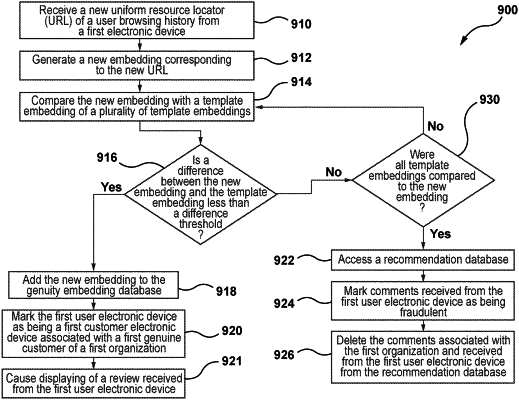| CPC G06Q 30/0185 (2013.01) [G06F 16/9566 (2019.01); G06Q 30/0282 (2013.01); G06Q 30/0609 (2013.01); H04L 63/126 (2013.01); H04L 67/535 (2022.05)] | 14 Claims |

|
1. A computer-implemented method for identifying, among user electronic devices, customer electronic devices associated with genuine customers of organizations, the method being executed by a server, the method comprising:
receiving, from a first user electronic device and by the server, a first review submission;
determining a first user ID associated with the first user electronic device;
determining a second user electronic device associated with the first user ID;
sending, to the first user electronic device, a first request to provide a first browsing history stored on the first user electronic device;
sending, to the second user electronic device, a second request to provide a second browsing history stored on the second user electronic device;
receiving, from the first user electronic device, the first browsing history;
receiving, from the second user electronic device, the second browsing history;
selecting, from the first browsing history and the second browsing history, a first uniform resource locator (URL) corresponding to the first review submission;
generating a first embedding corresponding to the first URL;
comparing, by the server, the first embedding with a template embedding of a plurality of template embeddings, the plurality of template embeddings having been retrieved from a genuity database;
in response to a difference between the first embedding and the template embedding being lower than an embedding difference threshold;
adding the first embedding to the genuity database,
determining a static portion and a dynamic portion of the first URL,
generating, based on the static portion, a pattern-based embedding corresponding to the first URL,
generating, based on the dynamic portion, a mask-based embedding corresponding to the first URL,
storing the pattern-based embedding and the mask-based embedding in the genuity database in association with the first URL, and
marking, by the server, all reviews associated with the first user ID, in a recommendation database, as having been provided by a genuine customer;
receiving, by the server and from a third user electronic device associated with a second user ID, a second review submission;
determining a second URL corresponding to the second review submission;
generating a second embedding corresponding to the second URL;
comparing, by the server, the second embedding with the template embedding; and
after determining that a difference between the second embedding and the template embedding is greater than the embedding difference threshold:
deleting, by the server and from the recommendation database, all reviews associated with the second user ID, and
storing, in a fraudulent user database, the second user ID.
|